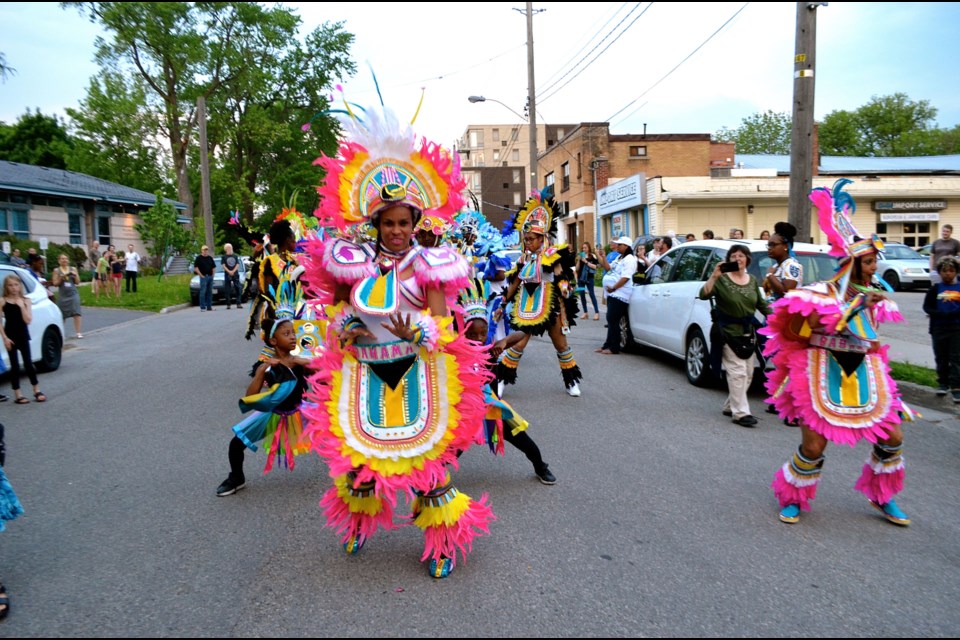The history and experiences of black communities and individuals who, in many cases, escaped to Canada during the African slave trade was the focus of a multi-media presentation Saturday that included street theatre, art, poetry, music and film.
The stories for The Crossings Project: Exodus, Exile and Transformation were collected by Kerry-Ann Cornwall from the Guelph Black Heritage Society and Andrew Hunter senior curator for the Art Gallery of Guelph.
”Black history, like many histories, has been erased while the dominant narrative has been told,” said Hunter. “The idea was to both reflect back on the history and to show that history is a living thing, that the artifacts of that time are still carried in people’s memories and bodies.”
The concept arose from the creative minds at Silence and was helped along with grants from the Canada Council for the Arts, the Guelph Community Foundation/Musagetes Fund and the International Institute for Critical Studies in Improvisation.
“Two of our key members at Silence, Daniel Fischlin and Gary Diggins came up with the concept of partnering with the Guelph Black Heritage Society and tracing the passage of black slaves from America to Canada via the Underground Railroad,” said Silence’s executive director Petra Nyendick. “We thought together we could come up with a pretty super project.”
Diggins brought together the best people he could find from the community to tell the stories in a creative and collaborative way.
“I asked Andrew Craig if he would be the musical director and I asked Tabby Johnson if she would focus on the piece at the church,” said Diggins. “Once we had those key players, then I approached the Junkanoo All Stars. The power of music and storytelling through tough times has put wind in people’s sails.”
At the start of the event people were led into the darkened hall at Silence where the chairs were arranged to face one of the four corners of the room. The anemic glow of instrument panels and iPad screens was all that lit the darkness. Craig and fellow engineer Lewis Melville directed four separate channels to guarantee each of the four groups had different audio experiences.
The opening sound of celebratory tribal drums and singing was shattered by the crackle of gunfire and screaming as slave traders rounded up men, women and children for their journey into bondage.
At the end of the performance people emerged from the darkness into the blinding daylight where a large crowd had gathered to watch dancers from the Junkanoo All Stars march down Essex Street to Heritage House.
“We wanted to draw attention to the fact that all the streets in this neighbourhood are named for British cities that thrived on slavery,” said Hunter. “There is a group of eight young people wearing black shirts with a black icon showing the bodies in the neighbourhood and the streets.”
Among the group of eight were sisters Reighen and Jaedin Grineage whose family can be traced back eight generations in Canada. They handed out pins with an icon on them.
“The imagery comes from the slave ships and how the bodies were placed on the ships originally,” said Grineage.
Also in the group of eight was Noah Brown whose large felt tapestry, hanging in Heritage Hall, is based on the Brookes Slave Ship plan from 1788 where slaves were stacked like cord wood.
As the marchers made their way toward Heritage Hall they were met by story teller tDeborah “Tabby” Johnson who sang a traditional slave song.
“Run Mary run,” she sang. “You got the right to the tree of life.”
Guelph poet Kevin Sutton welcomed everyone into Heritage Hall with a poem about our common ancestry.
“There is a truth we are here to witness today and that truth is, we are water,” said Sutton. “A stream of consciousness flows, steeped in an ocean of this ancestry because we are water.”
Inside Johnson spoke about her experiences with alienation and bigotry of being discriminated against by whites for her darkness and by blacks for of her lightness. She said many of the barriers are coming down but the journey isn’t over.
“Just because something is okay it doesn’t mean it can’t get better,” said Johnson. “How far ahead are we going to plan?”